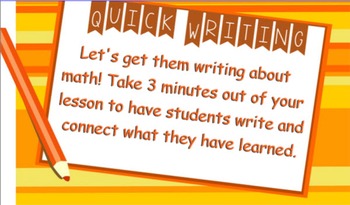Geometry Writing Prompts
Miss Lauren
414 Followers
Grade Levels
8th - 10th
Subjects
Resource Type
Standards
CCSSMP3
Formats Included
- NOTEBOOK (SMARTboard) File
Pages
31 pages
Miss Lauren
414 Followers
Description
We need to encourage students to write more in our math classes. This collection of 29 quick writes is a great way to take 3 minutes out of your day to have them write about what they have learned.
Concepts addressed:
1) Geometry foundation vocabulary
2) Midpoint
3) Inductive Reasoning/Logic
4) Congruent Triangles
5) Special Triangle Segments
6) Triangle Inequalities
7) Trigonometry
8) Surface Area and Volume
9) Area (including Composite)
10) Circles (arc length)
11) Similar Triangles
12) Parallel/Perpendicular Lines
Disclaimer: Helper Words are included for each Quick Write to assist students with limited English proficiency.
Concepts addressed:
1) Geometry foundation vocabulary
2) Midpoint
3) Inductive Reasoning/Logic
4) Congruent Triangles
5) Special Triangle Segments
6) Triangle Inequalities
7) Trigonometry
8) Surface Area and Volume
9) Area (including Composite)
10) Circles (arc length)
11) Similar Triangles
12) Parallel/Perpendicular Lines
Disclaimer: Helper Words are included for each Quick Write to assist students with limited English proficiency.
Total Pages
31 pages
Answer Key
Does not apply
Teaching Duration
N/A
Last updated Jan 18th, 2015
Report this resource to TPT
Reported resources will be reviewed by our team. Report this resource to let us know if this resource violates TPT’s content guidelines.
Standards
to see state-specific standards (only available in the US).
CCSSMP3
Construct viable arguments and critique the reasoning of others. Mathematically proficient students understand and use stated assumptions, definitions, and previously established results in constructing arguments. They make conjectures and build a logical progression of statements to explore the truth of their conjectures. They are able to analyze situations by breaking them into cases, and can recognize and use counterexamples. They justify their conclusions, communicate them to others, and respond to the arguments of others. They reason inductively about data, making plausible arguments that take into account the context from which the data arose. Mathematically proficient students are also able to compare the effectiveness of two plausible arguments, distinguish correct logic or reasoning from that which is flawed, and-if there is a flaw in an argument-explain what it is. Elementary students can construct arguments using concrete referents such as objects, drawings, diagrams, and actions. Such arguments can make sense and be correct, even though they are not generalized or made formal until later grades. Later, students learn to determine domains to which an argument applies. Students at all grades can listen or read the arguments of others, decide whether they make sense, and ask useful questions to clarify or improve the arguments.





